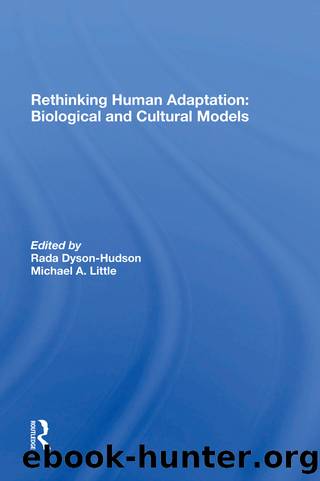Rethinking Human Adaptation by unknow

Author:unknow
Language: eng
Format: epub
Tags: Social Science, Anthropology, General
ISBN: 9781000238068
Google: CmQPEAAAQBAJ
Barnesnoble:
Publisher: Routledge
Published: 2019-06-26T00:00:00+00:00
In further considering how intergroup competition is generated, I turn now to group organization resulting from competition within a defended territory. Dominance hierarchies consist of a system of asymmetric compromises resulting from competition among individuals within a group over rights of access to limiting resources (Williams 1966: 218). Dominant individuals control resources which they share within a group in return for some benefit they accrue in the way of services. Such services include aid in defense and/or accumulation or production of resources. Subordinate individuals will accept a less advantageous position in the hierarchy as long as they benefit relative either to the costs of attempting to oust the dominant individual(s) or to the cost of emigrating from the group entirely. Thus, the dominant individual's strategy is to attempt to persuade lower ranking individuals to maintain noncompetitive affiliative roles, either through force or through rewards involving sharing of resources. However, dominant-subordinate transactions may not entail actual resources, but may instead take the form of deception or ideological manipulations involving the passing of "artificial currency" having little or no resource value at all (Glutton-Brock and Harvey 1978: 300).
Social hierarchies in human societies are very complex systems composed of dominant-subordinate relations among individuals, kin groups, coalitions of non-related individuals, or any combination thereof. Complex hierarchies can be "nested" or "stratified." This is an aspect of organization which is of more than passing significance, since it is within these sub-groups that expectations regarding access to resources are circulated. These expectations, which correspond to "values," form the basis for competition for positions in the hierarchy. The intensity of competition, along with the potential for mutualism leading to the formation of controlling coalitions, increases towards the top of the hierarchy (cf. Dickemann 1979: 324-325 for a similar point). The form and content of values or expectations regarding rights to resources at any given time are dependent upon the history of social interactions within the group and with other groups, and are therefore not directly reducible to considerations of population size or density, resource availability or other ecological conditions.
Some behavioral ecologists have noted that social hierarchical organization is a significant force for population dispersion (Brown 1975: 97-123; Christian 1970). As Brown (1975: 113) has stated, "A natural response of an individual living in a state of forced subordination is to try to find an area where he can be dominant." In the same sense that dominance behavior is the social analog of territoriality (Wilson 1971: 196), individuals in groups who disperse as a result of subordination effects are analogous to "floaters" produced by exclusion effects in single individual territorial systems. Like "floaters," individuals dispersing as a result of subordination effects are often characterized by relatively higher mortality rates and lowered reproduction rates (Brown 1975: 98). Among competitive human groups, dispersion resulting from subordination effects can take the form of direct aggression against neighboring groups. Controlling individuals or coalitions can be expected to encourage subordinates in this activity when the alternative is having the competition directed against themselves.
Download
This site does not store any files on its server. We only index and link to content provided by other sites. Please contact the content providers to delete copyright contents if any and email us, we'll remove relevant links or contents immediately.
Never by Ken Follett(2905)
Machine Learning at Scale with H2O by Gregory Keys | David Whiting(2314)
The Man Who Died Twice by Richard Osman(2307)
Fairy Tale by Stephen King(2089)
Will by Will Smith(2060)
Reminders of Him: A Novel by Colleen Hoover(1888)
Rationality by Steven Pinker(1773)
The Stranger in the Lifeboat by Mitch Albom(1546)
New Morning Mercies: A Daily Gospel Devotional by Paul David Tripp(1373)
Friends, Lovers, and the Big Terrible Thing by Matthew Perry(1342)
The Becoming by Nora Roberts(1337)
A Short History of War by Jeremy Black(1304)
The Strength In Our Scars by Bianca Sparacino(1274)
HBR's 10 Must Reads 2022 by Harvard Business Review(1260)
The Fall of Babel by Josiah Bancroft(1240)
Can't Hurt Me: Master Your Mind and Defy the Odds - Clean Edition by David Goggins(1239)
515945210 by Unknown(1216)
Fear No Evil by James Patterson(1116)
Love on the Brain by Ali Hazelwood(1112)
